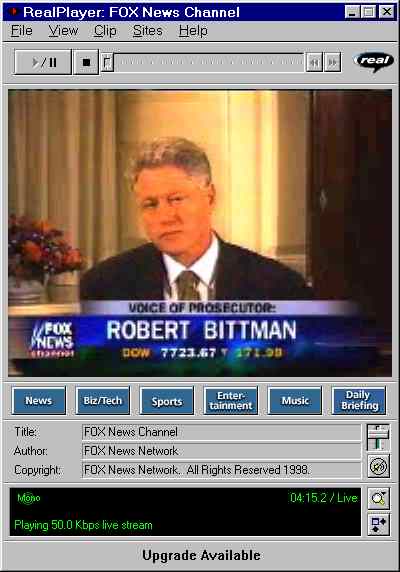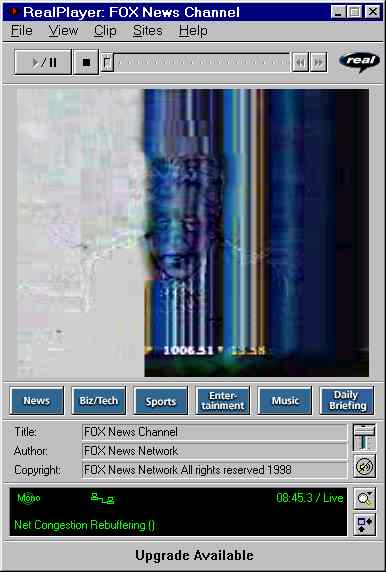Copyright (c) 1998 by Timothy C. Barmann. This article is intended for personal viewing only and may not be re-distributed in any form. Please e-mail link requests.
September 27, 1998
Clinton broadcast shows
Internet still has a ways to goBy Timothy C. Barmann
The Internet let me down big time last Monday.
It was the day President Clinton's grand jury testimony was broadcast live on television and simultaneously through the Net. Like tens of thousands of others, I tuned in on the Web. At least I tried to.
I knew it was going to be tough going when a link on the C-SPAN web site gave the response "Server alert: This server has already reached its capacity for the requested url."
And Clinton hadn't even appeared yet.
At times the live broadcast of President Clinton's grand jury testimony looked fine (above). Other times, the quality of the picture deteriorated (below). I found room at the Fox News Web site, and within a few minutes I was up and running with a video on my screen of the Clinton testimony videotapes being delivered to a broadcast booth.
To be sure, this was not television as we know it. The picture was jumpy and small, about the size of a Post-It note. And large pixels that made up the picture were visible, hiding detail. Still, you could see basically what was happening, and the audio wasn't bad.
Things were fine until the Clinton tape began. That's when my connection just died. Back to the Fox home page, I connected again. Working.
But periodically, the picture froze, and a message appeared saying "Net Congestion Rebuffering." Translated, that means: There are so many people interested in this video, pal, you're out of luck for the moment.
I tried CNN's Web site and found that the video it was relaying over the Web was lower in quality than the Fox site. The CNN feed was intended for connections at 28.8 Kbps, while the one at Fox gave the option to those with a faster connection.
Back to Fox's site.
At times the Clinton video would get worse, sometimes turning into a negative image or sometimes the picture would look like it was dripping. On the screen below the video image was a message saying "upgrade available" so I thought maybe the latest version of RealPlayer, the free software that plays the video, would help.
I downloaded the 2.4 megabyte file, installed it, and found things went from bad to worse. At times the new software wouldn't even connect. Once it did, the picture and the sound were way out of sync. I could hear a lawyer speaking while the President's mouth was moving.
I re-installed the older software and ended up back where I started: lots of out-of-luck-pal messages.
Apparently my experience wasn't unique.
"If this was the first time someone was experiencing video on the Internet, it probably was not the best day to do it," said Greg Makush, product manager for Real Broadcast Network, as quoted by ZD Network News, an on-line technology news service. Real Broadcast Network is part of RealNetworks, of Seattle, which provides most of the software people use to view video over the Web.
Video over the Web has gotten a lot of attention recently, starting this summer with America's Health Network's live broadcast of the birth of a baby on June 16, via its Web site. That event was even harder to view than the Clinton tapes because the site could not handle all the interest it generated.
That video is still on-line at http://www.ahn.com/livebirth/index1.htm. But even this week, I still couldn't view it because of an "error 29," which I learned later meant "The server is already providing the maximum number of streams. Try again later."
Out of luck again.
It seems clear that we're far from achieving television-like pictures and even farther from television-like reliability over the Web.
But Peter Mottur is banking on that problem being only temporary.
He's president of a small Newport company that is developing its own broadcast network of shows whose content revolves around the oceans, water and marine life. What's unusual is that the shows are broadcast only over the Internet.
The six-person company, Hydro Active LLC, is putting together its own programming and is also licensing it from others. Most of the programming is educational, but some is for entertainment, Mottur said.
The big attraction on the company Web site is the "Narragansett Bay Cam" which broadcasts live pictures from a camera mounted on top of the Doubletree Islander Hotel on Goat Island in Newport (http://www.hydroactive.com/video.htm). A Web cam operator can control the camera from the company office about a half-mile away.
On sunny days, you can see sailboats meandering along Narragansett Bay. The camera broadcasts from 7 a.m. to 7:30 p.m. At other times, a live picture of a small fish tank appears.
The site provides connections for those who are using slower modems, as well as those who have an expensive, high-speed line to the Internet, such as a cable modem or an ISDN line. When viewed from a fast Internet connection, the Bay Cam picture is impressive. The picture changes 10 times a second.
Mottur says that faster access is the key to making video over the Internet closer to what we expect from television.
The industry is still young, Mottur said, and he acknowledges we have a long way to go to match what television brings us today.
He thinks it could be as soon as two years when we see broadcast-quality video over the Web.
"I think inevitably that it will get there. It's just a question of when and how much its going to cost the end users."
Timothy C. Barmann is a Journal-Bulletin staff writer. His column runs every other Sunday on the Computers and Technology page. Send him comments via e-mail at tim@cybertalk.com or U.S. mail, c/o the Journal-Bulletin, 75 Fountain St., Providence, R.I. 02902.
![[Cybertalk logo]](http://www.cybertalk.com/ctsm.gif)



